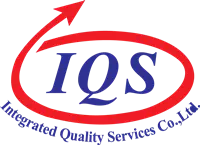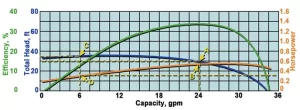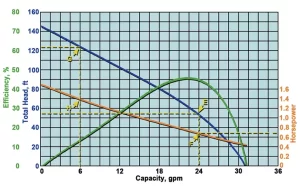รีเจนเนอเรทีฟ เทอร์ไบน์ปั๊ม
(Regenerative turbine pump, Vortex pump, Peripheral pump)
รีเจนเนอเรทีฟปั๊ม หรือ รีเจนเนอเรทีฟ เทอร์ไบน์ปั๊ม คือโรโตไดนามิคปั๊ม (Rotodynamic pump) ที่พลังงานถูกถ่ายทอดจากโรเตอร์ที่ถูกขับหมุนด้วยความเร็วรอบสูงไปสู่แก๊ซซึ่งอยุ่ในร่องใบพัด (Chamber) ของของโรเตอร์ซึ่งเป็นใบพัดหลายใบ (Multiblade - double face rotor) ซึ่งอยู่ภายในในตัวปั๊ม แก๊สจะถูกแรงเหวี่ยงจากการหมุนของโรเตอร์ จะวิ่งกลับไปกลับมาหลายๆ (Create a spiral regenerative action) รอบผ่านร่องใบพัดของโรเตอร์ (Multi blade, Multi vane construction) และสเตเตอร์ (Channel shape stator, Casing) สเตเตอร์ไกด์ของใหลให้กลับเข้ามายังร่อง (Channel) ของใบพัดตัวถัดมา การใหลจะสลับกันไปมา (Regenerative turbine) ตามร่องของโรเตอร์และสเตเตอร์ ทุกครั้งที่วิ่งผ่านโรเตอร์แต่ละร่องของใหลจะถูกเร่งความเร็ว (Accelerate) ให้สุงขึ้น ซึ่งความเร็วรอบที่ถูกเร่งสูงขึ้นจะถูกเปลี่ยนเป็นความดันให้สูงขึ้นตาม รีเจนเนอเรทีฟปั๊มมีการใหลของๆเหลวออกจากโรเตอร์ทั้งสอดด้านทำให้เกิดการบาลานส์ (Balance) หรือสมดุลย์ในตัว ไม่เกิดแรงในแนวแกนกระทำต่อแบริง
เจนเนอเรทีฟปั๊มเป็นปั๊มจะมีคุณสมบัติที่มีการใหลต่อเนื่องและสม่ำเสมอ ที่ขนาดโรเตอร์และความเร็วรอบเดียวกันปั๊มจะทำความดันได้สูงกว่าปั๊มหอยโข่ง (Volute type – centrifugal pump) มาก เป็นปั๊มที่มีความดันของระบบจะเปลี่ยนแปลงน้อยเมื่อปริมาณการใหลที่เปลี่ยนแปลงไป (Steep performance curve)
รีเจนเนอเรทีฟปั๊มมีคุณสมบัติการใช้งานที่มีความต้องการระหว่างปั๊มหอยโข่งกับพีดีปั๊ม (Positive displacement pump) คือต้องการปริมาณการใหลน้อย แต่ต้องการความดันสูง ซึ่งปั๊มหอยโข่ง (Centrifugal pump) และพีดีปั๊มมีคุณสมบัติไม่เหมาะสม
รีเจนเนอเรทีฟปั๊มเป็นปั๊มที่ต้องการ NPSH ค่อนข้างต่ำ และมีประสิทธิภาพสูง ติดตั้งใช้งานง่าย
รีเจนเนอเรทีฟปั๊มใช้กับอากาศ ไอ (Vapor) และของเหลวได้โดยไม่เกิดการใหลที่ไม่สม่ำเสมอ (Pulsation flow)
รีเจนเนอเรทีฟปั๊มเป็นปั๊มที่เงียบ (Quiet) ในการเดินเครื่องใช้งาน ชิ้นส่วนสัมผัสกันน้อย

รีเจนเนอเรทีฟปั๊มมีลักษณะ
- ออกแบบง่ายๆ ใช้วัสดุทั่วไป (Basic housing materials: stainless steel, brass, ductile iron, cast iron, polymers)
- วางปั๊มกับมอเตอร์บนฐานเดียวกัน (Close coupled and base plate mount models)
- ใช้แมกเนทิคไดร์ หรือแคนเนดมอเตอร์ ไม่มีการใช้ซีล (Magnetic drive, canned motor or mechanical seal)
- ใช้กับความหนืดถึง 100 cSt (Viscosity to 100 cSt)
- มีทั้งแบบตั้งแนวดิ่งและแบบแนวนอน (Vertical (seal-less) or horizontal configurations)
- หมุนได้ 2 ทาง (Reversing option)
- ใช้กับอุณหภูมิได้สูง 660 F (Temperature to 660° F)
- ใช้มอเตอร์มาตรฐานทั่วไป (Motors: Standard NEMA, ISO or special OEM)
- โครงสร้างเล็ก กระทัดรัด มีประสิทธิภาพสูง
โครงสร้างของรีเจนเนอเรทีฟปั๊ม
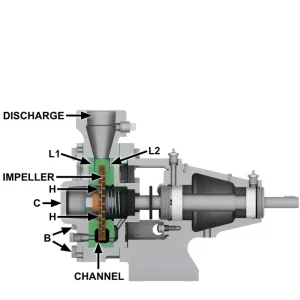
โครงสร้างของโรเตอร์หรือใบพัดของรีเจนเนอเรทีฟปั๊ม
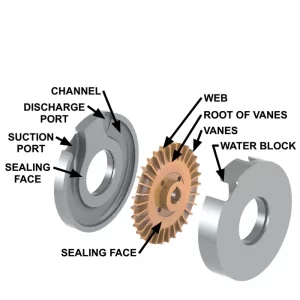
รูปแสดงการสร้างความดันของรีเจนเนอเรทีฟปั๊ม
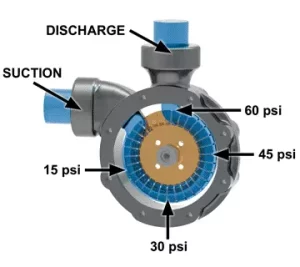
รูปแสดงเปรียบเทียบการทำงานของรีเจนเนอเรทีฟปั๊มและปั๊มหอยโข่ง
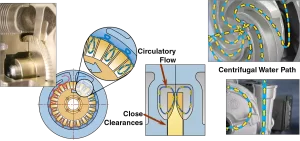
รีเจนเนอเรทีฟปั๊มมีหลายชนิดขึ้นกับคุณสมบัติของการใช้งาน
- แบบใบพัดเดี่ยว (Single-Stage Regenerative Turbine Pumps) ใช้กับระบบที่ใช้ความดันไม่สูงมาก เช่นปั๊มน้ำใช้ตามบ้าน ระบบ HVAC เป็นต้น
- แบบหลายใบพัด (Multi-Stage Regenerative Turbine Pumps) แบบต้องการความดันสูง เช่นในระบบเติมน้ำเข้าหม้อน้ำ (Boiler feed system) ระบบรีเวอส์ออสโมซิส (Reverse osmosis) ระบบการผลิตทางเคมี (Laser cooling system) เป็นต้น
- แบบความเร็วรอบสูง (High-Speed Regenerative Turbine Pumps) แบบต้องการความดันสูง และปริมาณการใหลสูง เช่นในระบบทำความเย็น (Refrigeration system) ระบบทำความเย็นของเลเซอร์ (Laser cooling system) เป็นต้น
สมรรถนะของรีเจนเนอเรทีฟปั๊ม
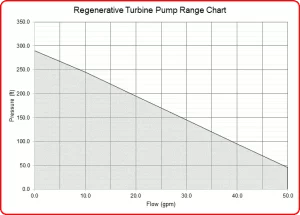
กราฟแสดงสมรรถนะของริเจนเนอเรทีฟปั๊มเทียบกับปั๊มหอยโข่ง
แฟคเตอร์ในการการเลือกรีเจนเนอเรทีฟปั๊ม
- กราฟสมรรถนะของปั๊ม (Pump Curve) Relationship between flow rate, head pressure, and efficiency. This helps you visualize how the pump will perform under different operating conditions.
- ประสิทธิภาพ (Efficiency) Pump’s efficiency across a range of flow rates. A pump that maintains good efficiency over varying conditions is ideal for applications with fluctuating demands.
- การใช้พลังงาน (Power Consumption) Power consumption at different flow rates. Balances performance with energy efficiency.
- วัสดุที่ใช้สร้าง (Materials of Construction) Materials used, including the impeller, diffuser, casing, and seals. Ensure they are compatible with the fluid and the operating environment.
- ความต้องการบำรุงรักษา (Maintenance Requirements) maintenance needs, including part replacement, lubrication, and general upkeep.
- ความเชื่อถือได้ (Reliability) และความคงทน (Durability) Manufacturer’s reputation for producing reliable and durable equipment.
- แอลซีซี (LCC cost Considerations) Overall life-cycle cost, including energy consumption, maintenance, and potential downtime.
การวิเคราะห์ปัญหาในการใช้งานเบื้องต้นของรีเจนเนอเรทีฟปั๊ม
- เช็คคุณสมบัติของของใหล (Check Fluid Properties) Any changes in viscosity, temperature, or chemical composition that might affect pump performance.
- ตรวจดูสภาพซีลและแบริง (Inspect Seals and Bearings) Replace worn components promptly to avoid further damage.
- ตรวจการสั่นสเทือนและเสียงผิดปรกติ (Monitor Vibration and Noise) Vibration or noise may indicate misalignment or damaged components.
- เช็คอุณหภูมิ (Check Temperature) Abnormal temperature indicate excessive friction or an imbalance in the pump.
- ดูค่า NPSH (Verify NPSH) Net Positive Suction Head (NPSH) requirement is met to prevent cavitation.
- ตรวจดูใบพัดและตัวดูด (Impeller and Diffuser) Inspect impeller and diffuser components for wear, corrosion, or damage.
- ตรวจดูการใช้พลังงาน (Review Power Consumption) Indication of increased resistance due to worn parts or improper clearances.
- ตรวจดูระบบไฟฟ้า (Check Electrical Components) Inspect wiring, connections, and the motor for any issues that could affect power delivery.
การวิเคราะห์ปัญหาในการใช้งานของรีเจนเนอเรทีฟปั๊มโดยใช้เครื่องมือ
- การวัดการสั่นสะเทือน (Vibration Analysis) Diagnosis of imbalances, misalignments, and wear in pump components.
- การวัดความร้อน (Thermography) Identify areas of excessive heat that might indicate friction or component malfunctions.
- การทดสอบสมรรถนะ (Performance Testing) Test to verify that the pump is achieving the expected flow rates and pressures.
- การวิเคราะห์คุณสมบัติของๆใหล (Fluid Analysis) Contaminants, pH changes, or chemical reactions that could affect pump performance.
ประโยชน์ของรีเจนเนอเรทีฟปั๊ม
- ความสามารถปรับแต่ง NPSH (NPSH Optimization)
- ความสามารถสร้างแรงดูดในตัว (Self-Priming Capability)
- ความสามาถป้องกันการเกิดแควิเตชั่น (Efficient Cavitation Prevention)
- ความสามารถสร้างให้แข็งแรงใด้ (Robust Construction)
- รีเจนเนอเรทีฟปั๊มจะใช้ในอุตสาหกรรมในการผสมระหว่างแก๊สและของเหลว เพื่อการทำให้เกิดฟองน้ำอย่างละเอียด (Micro bubbles) และละเอียดยิ่ง (Nano bubbles) ซึ่งฟองในน้ำจะช่วยให้สารเคมีทำให้ปฏิกริยาได้ดียิ่งขี้น
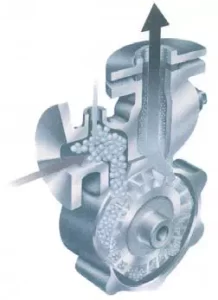
ภาพแสดงโครงสร้างของไมโครบับบีลปั๊ม
ชนิดของการเลือกใช้งานรีเจนเนอเรทีฟปั๊ม
1. Boiler Feed Service
2. Booster Service
3. Car & Truck Washes
4. Chemical Processing
5. Chillers
6. Circulation
7. Condensate Return
8. Coolant Systems
9. Cooling
10. 12 Volt DC Wash-down Pumps (Portable Restroom Trucks)
11. DI Water Handling
12. Dissolved Air Flotation (DAF)
13. EDM Machines
14. Filter Back Flush
15. Fire Systems (Jockey Pumps)
16. Fluid Handling
17. Fluid Transfer
18. Fuel Cells
19. Groundwater
20. Remediation
21. Heat Exchangers
22. High Head, Low Flow
23. Hot Water Pumping
24. Hydrostatic Testing
25. Jockey Service
26. Laboratory Equipment
27. Laser Cooling
28. Low NPSH
29. Machine Tool High Pressure Coolant
30. Medical Imaging
31. Misting
32. Mixing
33. Pressure Injection
34. Refrigeration
35. Reverse Osmosis
36. Sampling Pumps
37. Seal Flushing
38. Spraying
39. Temperature Control
40. Wash Down Service
